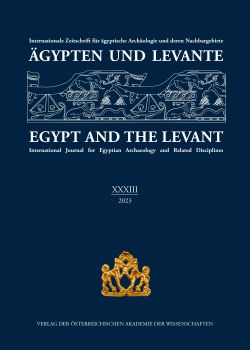 |
 |
Manfred BIETAK (Editor in Chief) - Ernst Czerny - Christiana Köhler - Nadine Moeller - Karol Myśliwiec (Eds.)
Ägypten und Levante XXXIII
Egypt and the Levant XXXIII
Internationale Zeitschrift für ägyptische Archäologie und deren Nachbargebiete
International Journal for Egyptian Archaeology and Related Disciplines
Jozef Hudec,
Lucia Hulková,
Veronika Verešová,
Alena Šefčáková,
Anna Wodzińska,
Květa Smoláriková,
Miroslav Černý
S. 21 - 74 doi: 10.1553/AEundL33s21
Verlag der Österreichischen Akademie der Wissenschaften doi: 10.1553/AEundL33s21
Abstract:
This article presents preliminary results from the 2019 and 2021 excavation seasons at Tell el-Retaba. In Area 4, the focus was on settlement activities spanning the Second Intermediate Period and the late New Kingdom. In Area 2, exploration delved into a settlement and defence structures of the New Kingdom and the Third Intermediate Period. Area 4 underwent a change from a settlement at the beginning of the Second Intermediate Period to a cemetery of the same period used continuously into the early 18th Dynasty. It was only later during the 18th Dynasty, that the excavated area reverted to a settlement of mudbrick houses. A rich assemblage of small finds and a battery of ovens bear witness to the lively industrial activity or craftsmanship of its inhabitants, and their long-distance contacts. The discovery of a walkway, dating to Phase D4, adds an intriguing detail to 20th Dynasty military architecture. Isolated finds from the Third Intermediate Period (Phase C) demonstrate the spread of the settlement, known from previous excavations, further north on the tell. In 2021, work shifted to Area 2, separated from Area 4 by a ca. 20 m wide recent asphalt road. On the northern edge of the explored part of Area 2, two massive walls in partial supraposition were uncovered. The upper one exhibits construction similarities with the walls of the Ramesse III fortifications; however, the function and date of the lower wall have not been solidly established yet.
Second Intermediate Period, New Kingdom, Third Intermediate Period, cemetery, burial customs, settlement, street, defence wall Published Online:
2024/02/28 15:02:31 Object Identifier:
0xc1aa5576 0x003ed9ba
Rights:All rights reserved.For questions regarding copyright and copies please contact us by email.
Die Zeitschrift Ägypten und Levante wurde im Jahr 1990 von Manfred Bietak begründet, um den Forschungen zu den Kulturkontakten zwischen Ägypten und seinen Nachbarländern sowie der ägyptisch-kanaanäischen Hybridkultur, wie sie vor allem bei den österreichischen Ausgrabungen in Tell el-Dab’a zutage trat, eine Publikationsplattform zu bieten. Von Anfang an war die Zeitschrift international und interdisziplinär ausgerichtet. Das Themenfeld geht über die ursprüngliche Kernthematik weit hinaus und umfasst sowohl Vorberichte und Berichte zu archäologischen Grabungen in Ägypten und dem gesamten Vorderen Orient sowie Nubien und dem Sudan, wie auch Artikel zu allen Aspekten der ägyptischen und nahöstlichen Archäologie, Geschichts- und Kulturwissenschaft. Der Fokus liegt auf der pharaonischen Zeit, jedoch sind sowohl Beiträge zur Ur- und Frühgeschichte der genannten Regionen wie auch zur nachpharaonischen Antike möglich. Dazu wird ein weites Feld an naturwissenschaftlichen Themen abgedeckt, von Fragen der C14-Datierung über materialkundliche Untersuchungen bis hin zu archäobotanischen, archäozoologischen und anthropologischen Arbeiten.
Ägypten und Levante erscheint einmal jährlich im Druck und online. Die Redaktion ist bemüht, eingereichte Artikel möglichst zeitnah zu publizieren. Beiträge sind in Deutsch, Englisch oder Französisch einzureichen. Buchbesprechungen und Rezensionen werden nicht publiziert. Alle eingereichten Artikel werden einem internationalen peer-review Verfahren gemäß den Qualitätsstandards der Österreichischen Akademie der Wissenschaften unterzogen.
Egypt and the Levant was founded by Manfred Bietak in 1990 to provide a publication platform for the research on cultural contacts between Egypt and her neighbours. A focus of interest was the Egyptian-Canaanite fusion of cultures, which was mainly encountered at the site of Tell el-Dab’a during the Austrian excavations. From the beginning, the scope of the journal was international and interdisciplinary. The subject area has now been greatly expanded far beyond the original topics. It comprises reports and preliminary reports on archaeological excavations in Egypt and the entire Middle East including the Sudan, as well as articles dealing with all aspects of Egyptian and Near Eastern archaeology, history or cultural history. The main emphasis lays on the pharaonic period, but both contributions to prehistory of the said regions, and post-pharaonic periods may be accepted. In addition, a broad range of scientific topics is covered, including C14-dating, material analyses, archaeobotanical and archaeozoological studies as well as studies in physical anthropology.
Egypt and the Levant is published on an annual basis, both in print and online. Submitted articles are intended to be published in a timely manner. Manuscripts may be submitted in English, German or French. Book reviews are not accepted. All submitted articles are subject to international peer-review according to quality standards of the Austrian Academy of Sciences.
|



 Home
Home Print
Print
 References
References
 Share
Share
